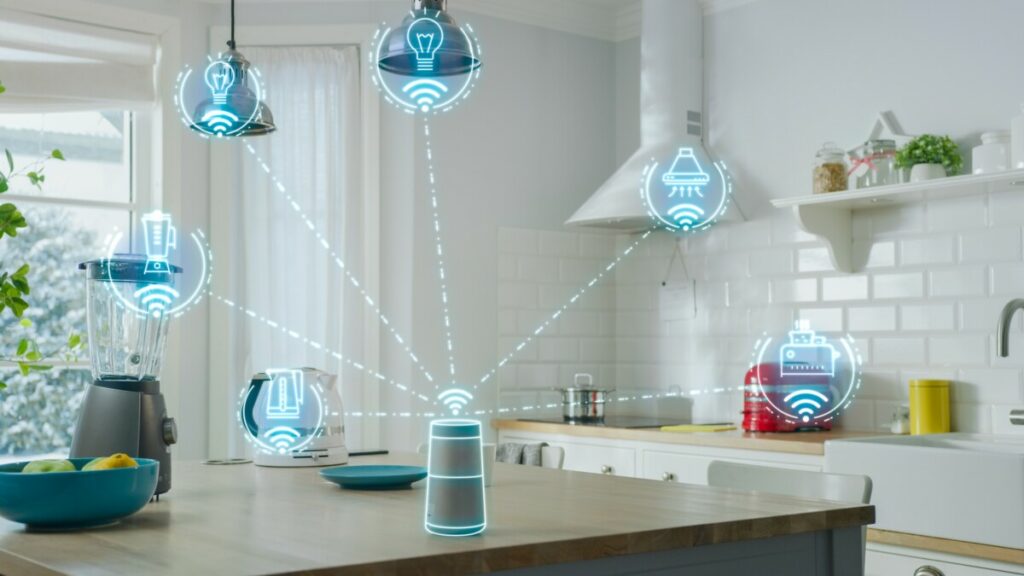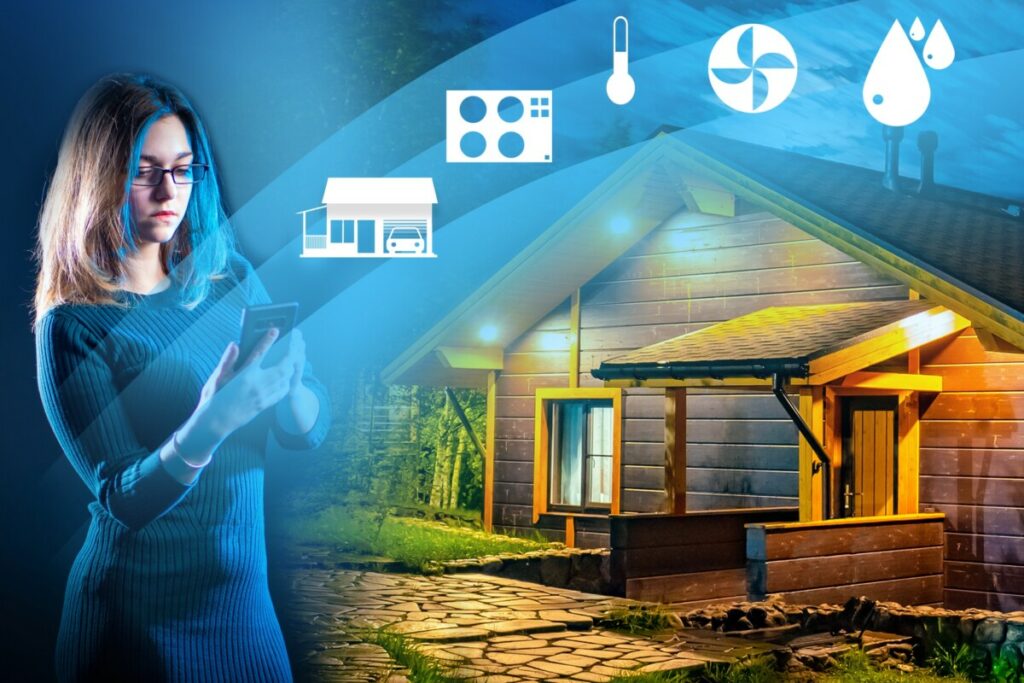- Making the Most of Your Smart Home: Common Use Cases - March 28, 2023
- Eco Mode at Night: Maximizing Nest’s Energy Savings - March 20, 2023
- Connecting & Controlling Smart Home Devices: A Guide - March 18, 2023
Disclosure: Links marked with * are Affiliate Links. As an Amazon Associate, I earn from qualifying purchases if you decide to make a purchase through these links – at no cost for you!

As more advanced technology enters the market, American households transform into smart homes. These smart homes are incredibly well-designed and continue to save consumers money and preserve energy. However, many people wonder how these smart homes are able to be so energy efficient, and if smart homes really save energy at all.
Smart homes can effectively minimize energy consumption by regulating which household appliances are actively being used such as lowering room temperature until you get home. Many similar settings are available to limit energy consumption to only functional appliances and services.
There is a large variety of household appliances and features that have “smart” capabilities, and there are constantly new smart products being released to consumers. Read on to learn about some of the ways that smart homes are more energy efficient and how these smart home features really are able to limit energy consumption within a household overall!
Here you can find my favorites for saving energy: Best Smart Plugs with Energy Monitoring – List & Guide
Table of Contents
How Do Smart Homes Save Energy?
With such a technologically driven society, it is not surprising that the United States has such high energy consumption. Based on data from the calendar year of 2021, each US resident used approximately 10,632 kilowatt-hours and around 886 kWh per month. This being said, there are new product releases that are beginning to take this high energy consumption into account, and efforts are being taken to combat this issue. Smart homes are beginning to limit energy use within households throughout the United States of America.
Smart technology provides more accessibility and control over the use of energy-using products and appliances throughout the home. This includes but is not limited to refrigerators, light bulbs, sprinklers, air conditioning, heaters, doors, windows, security systems, garage doors, light switches, and even water pipes!
In traditional homes, these are all ways that energy is being used constantly throughout the day and night, even though no one is actively using them for more than 50% of the time that they are actively using energy. However, when these items are smart home products, owners are able to easily monitor and adjust the amount of energy that is being used in nearly every aspect of everyday living, transferring the energy to only the appliances actively being used, and lowering or stopping the energy consumption completely when no one is home or actively enjoying the use of these appliances. Read on to learn about some of the smart appliances currently used in American homes to be more energy-efficient and aware of our energy consumption.
Benefits of a Smart Home Thermostat
One of the coolest and most energy-efficient smart home products is found in the smart thermostat. Homes of the past will leave the air conditioner or the heating system on in the home all day long, even though most families are gone during a large portion of the day. Many American families even left these air conditioners and heaters on when leaving for trips and vacations, which not only increased their heating and cooling bills but wasted tons of energy on a service that no person was even using at the time. While it may seem appealing to come home to an even temperature, this really isn’t worth the amount of energy that is completely wasted during the duration of your trip.
This is where smart thermostats come in. This technology has sensors that monitor the temperature in your home whether you are there or away. Owners can then connect their phones to these sensors and check the temperature of their homes from nearly anywhere they go with reception. Not only does this allow them to see the temperature of their homes on the go, but smart thermostat owners can also change the temperature from their smartphones as well.
With this option, homeowners can now enjoy the benefits of saving energy without wasting a moment of their time in the home waiting for the temperature to level out. A prime example of this is that the heating and cooling can be turned off completely when the last person leaves the house for the day. Then before returning home, the temperature can be raised or lowered as desired, depending on preferences and the weather, while still away so that the home will be perfectly ready temperature-wise for when the family returns.
According to a 2015 study, Nest Homes proved that smart thermostats can save the average household between 10% and 12% in heating prices and up to 15% in cooling costs. Heating and cooling bills look better with smart thermostats too, showing that more than just energy usage is improved with this smart household product. This also increases the homeowners’ control over the heating and cooling systems, with the ability to alter the temperature sitting in their pocket on their smartphone.
Smart Light Switches and Bulbs
In a similar way to that of the smart thermostat, smart light switches are technologically advanced and designed to minimize energy waste, while still providing their desired service to consumers. Smart light bulbs connect to the household Wifi network, which allows them to connect to your phone as well. Just as smart thermostat homeowners are able to program the heating to start and turn off when saving energy, smart light bulbs can be controlled from a mobile device as well.
No more zombie-walking from your bed to turn off that light down the hallway you left on on the way to your room, simply pick up your phone and flip it off yourself with smart bulbs! Better yet, program all of the lights in the house to turn off at the time you want to be in bed, and they can act as a sort of alarm because you can even have them automatically turn on when you need to be up in the morning too!
Energy can also be saved with smart light bulbs because you can dim or brighten the lights in a room from your smartphone as well. Lowering the brightness will allow your light bulbs to last much longer, and they can easily be brightened when you need more light for any reason. Smart light bulbs give you more lighting options, save energy, provide convenience in functionality, and can even help you maintain a consistent sleep schedule!
Energy-Efficient Features of Smart Home Refrigerators
Smart refrigerators are also more energy-efficient than the “dumber” models on the market. There are even convenience benefits that accompany these energy-saving upgrades as well. On a regular refrigerator, there is generally a smaller scale temperature range available within the settings. Not only can smart refrigerators provide more temperature options, but the control of these temperatures can be altered and tracked using your phone!
In addition to this feature, smart refrigerators save energy by allowing you to see the contents of the fridge from your mobile device as well. You can sit upstairs and check what is in the fridge without even leaving your seat. This is both convenient and efficient because it allows the fridge to remain closed and maintain the desired temperature without losing energy out the door as you leave it open to see what you would like to select from its contents. You will also get a notification on your phone if the refrigerator door is left open, allowing you to attend to the issue and close it before losing too much energy from this small mistake.

Control of Smart Sprinkler Systems
As a homeowner, it is safe to say that sprinkler systems can be among the most hated of household features. Everyone loves a beautiful green lawn, but trying to keep it watered just the right amount and at times that won’t inconvenience anyone in your family can be difficult. No one likes walking up to the front door after a long day to have the sprinklers turn on and pull the last straw on your patience and energy. This is another issue that smart homes have so conveniently chosen to address with their technological advancements.
Smart sprinkler systems can, as you may imagine, be controlled on your phone. Yes, that puts an end to digging through shelves and boxes trying to reveal the control panel on some unknown wall in the hot garage. These sprinkler systems are also connected to the weather forecast in your area, which means that they will automatically communicate with the irrigation system and won’t raise your water bill by watering the lawn in a downpour. Once again, smart home products are shown to save time, energy, stress, and planning, and replace them with convenience, energy efficiency, and free mental space to worry about other things while knowing that everything in this department is well taken care of.
Gauges for Smart Water Pipe Temperatures
On the subject of irrigation water for sprinklers, smart homes are also able to accurately detect leaks and freezing within pipes. This can save millions of dollars in the case that these notifications and sensors prevent you from flood and water damage, which can be incredibly expensive. These smart water leak detectors can be placed under sinks, in a shower or tub, or even around hot water tanks. They are useful for practically any water source or pipe that leads to one and can lower your water bill and save you from missing any chance of potential water damage as well.
Smart Home Security System and Motion Sensors
Motion sensors are rather self-explanatory devices. They are generally installed around the outside of homes to provide additional security measures, making you aware of movement on your property, or turning on lights for you when outside at night. For these purposes specifically, motion sensors are best when connected to lights and home security systems and cameras.
Many people are concerned about thieves and intruders who are likely to have lights that are on all over their property, especially in areas right around their homes, that shine all night to keep anyone from lurking in the dark unidentified. While these lights can ward off intruders and provide a better view for cameras, this is a huge waste of energy. Fortunately, smart home devices have come up with a solution for this as well, providing the desired service with energy efficiency benefits as well. Smart home motion sensors are connected to your phone and will notify you of movement in any area that you select, and over your desired periods of time as well. This allows homeowners to opt out of notifications when they know that the kids or a dog are outside and will likely be the ones setting off the detectors.
In addition to smartphones, motion sensors can be connected to light sources. This means that energy is not wasted keeping the lights on all night. They can be adjusted to only turn on when motion is detected, allowing cameras a better view of any intruders and causing them to think twice about approaching your home or trespassing in the area.
Other Benefits of an Energy-Efficient Smart Home
Having energy-efficient homes do a lot for their owners, just as their owners are doing a lot for the environment and for all other energy consumers. Smart home devices and technology allow homeowners the services they enjoy at a minimal cost to resources or energy sources. This will also save consumers money on light, water, heating, and other bills that are common when having a residence. These smart products even come with additional features that make everyday tasks and actions easier and more accessible.
Smart home products save money. With advancing technology, it is becoming more and more common for people to purchase homes that have at least some of these smart features installed. Having a smart home will likely increase the resale value of your home, as it will be more desirable than a traditional home without these benefits. As aforementioned, there is a lot of energy wasted in heating and cooling a home, keeping it well-lit, while only providing these services when they are being used. Less use will save money on these bills, increase your control, and do all of this with lower energy usage.
Attention: When installing electronic equipment, please be sure to observe the manufacturer’s safety instructions. You have to take care of your own safety. The information on this site only helps you to learn.
Disclosure: This website is the property of Martin Lütkemeyer and is operated by Martin Lütkemeyer. Martin Lütkemeyer is a member of the Amazon Services LLC Affiliate Program, an affiliate advertising program designed to enable Web sites to earn advertising revenue through advertising and linking to Amazon.com. Links marked with * are affiliate links.
